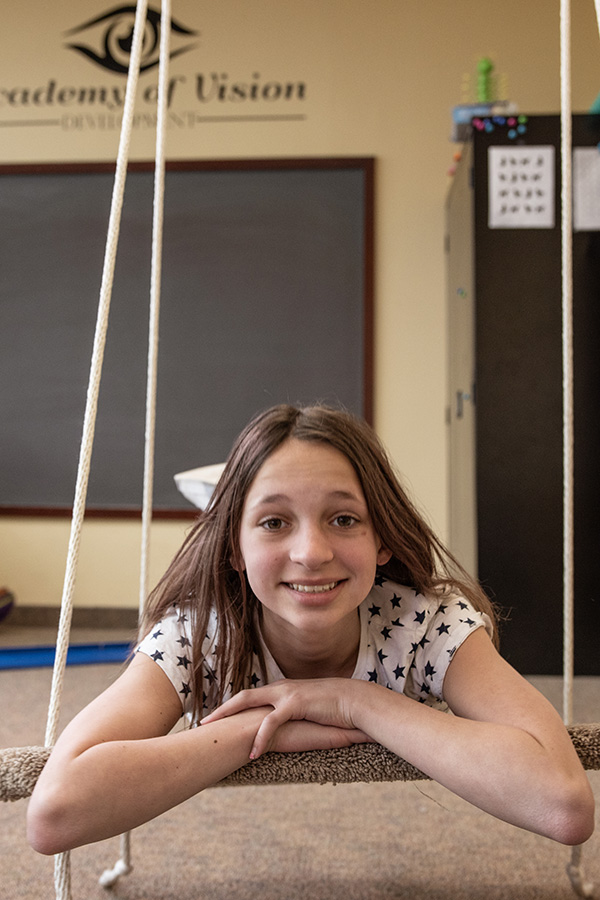
My Personal Introduction to Vision Therapy through My Daughter's Experience
As the mother of young children, I had worked filling in as an Optometrist in a variety of corporate and private practices for ten years. I worked part-time and scheduled my work according to the school calendar, field trips, and my husband’s busy work schedule.
When our oldest daughter, Elle, was in Kindergarten, I started noticing some “red flags.” Elle had been reading fluently for almost two years. One night, she asked for help with her math homework. She read the instructions out loud perfectly, then looked at me with tears in her eyes and said, “Now will you read it to me so I know what it says?” I was confused by her request but I did as she asked. After she listened to me repeat the instructions, she nodded her head and did her math. Although she was reading well above grade level, she was clearly struggling with reading comprehension.
Later that night I was discussing some other “red flags” with my husband, who happened to be a psychiatrist. He has a sister that struggled all through school with a dyslexia diagnosis, and I wondered if it was hereditary. Elle was often reversing WAS and SAW, and she would read a word on a page the first four times correctly (e.g., “chew”) and then sound out that same word at the bottom of the page (e.g., “ca-hu-you”). She needed me to read things back to her so she could understand them even though she could read every word perfectly well, and she was exhausted and would fall asleep in the car every day on the way home from half-day Kindergarten.
As the mother of young children, I had worked filling in as an Optometrist in a variety of corporate and private practices for ten years. I worked part-time and scheduled my work according to the school calendar, field trips, and my husband’s busy work schedule.
When our oldest daughter, Elle, was in Kindergarten, I started noticing some “red flags.” Elle had been reading fluently for almost two years. One night, she asked for help with her math homework. She read the instructions out loud perfectly, then looked at me with tears in her eyes and said, “Now will you read it to me so I know what it says?” I was confused by her request but I did as she asked. After she listened to me repeat the instructions, she nodded her head and did her math. Although she was reading well above grade level, she was clearly struggling with reading comprehension.
Later that night I was discussing some other “red flags” with my husband, who happened to be a psychiatrist. He has a sister that struggled all through school with a dyslexia diagnosis, and I wondered if it was hereditary. Elle was often reversing WAS and SAW, and she would read a word on a page the first four times correctly (e.g., “chew”) and then sound out that same word at the bottom of the page (e.g., “ca-hu-you”). She needed me to read things back to her so she could understand them even though she could read every word perfectly well, and she was exhausted and would fall asleep in the car every day on the way home from half-day Kindergarten.
The final straw was when her Kindergarten teacher sent a note home that said Elle was falling asleep in class and needed to get more sleep. We agreed she needed to see a specialist. I took her to work and did her eye exam. Her vision was 20/20, perfect right? So what could it be? What was our next step?
I had done a Vision Therapy-emphasized externship rotation during Optometry school, and I knew of a Vision Therapy Specialist near my home. I scheduled an appointment for Elle to have a Comprehensive Binocular Vision Examination. That examination BLEW ME AWAY (and remember, I’m an eye doctor?)! He focused much attention on Elle’s early development, current and past behaviors, and on testing the visual skills needed to comprehend reading material.
It turns out Elle was moving her whole head and neck muscles to read. She was not moving her eyes properly across a page of print. How the doctor explained it to us was, “If you’re holding a bowling ball in one hand and a ping pong ball in the other and you tossed them both in the air, which would be easier to catch, and why?” She answered, “The ping pong ball, because it’s smaller and lighter.” “Yes!” he exclaimed. “It’s just like that with your eyes. Your neck muscles move your whole head back and forth and it takes a lot more effort to move your whole head than it does to just move your tiny little eyeballs back and forth.”
This was so fatiguing to her that by the end of a page her eyes would go crossed. Since she is a rule follower, she manifested her discomfort with close-up work by falling asleep in the classroom.
Most children will have symptoms that overlap with ADD/ADHD; fidgety, disruptive, unable to sit still or in a chair when required, and difficulty with concentration and focus especially during near work.
The treatment for Elle included bifocal glasses which decreased the need for her eyes to come together when looking up close. We also did Vision Therapy to improve her ability to move her eyes.
When Elle came out of school the first day after getting her glasses, she had a giant smile on her face! Her teacher came up to me and stated, “Those are magic glasses!” It was the first time Elle left half-day Kindergarten energetic and happy, not exhausted and cranky. This was life-changing for my child and for our family!
